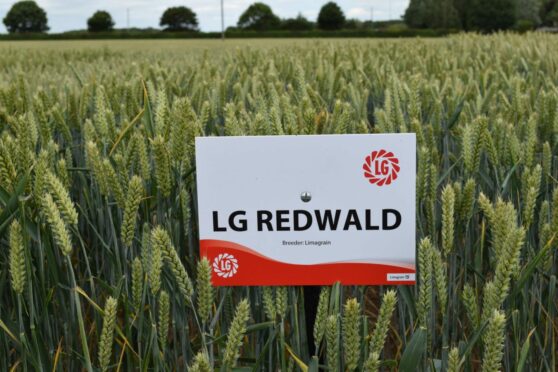Growers will have the option of planting the highest yielding winter wheat on the 2023/24 recommended list this autumn – LG Redwald.
The variety has proven to be a very consistent performer over multiple seasons and regions, producing RL yield scores of 107 for the UK and east, and 109 for the west.
This is driven by LG Redwald’s large biomass, high tillering capacity, and strong agronomics, notably strong Septoria resistance, inherited from its LG Sundance parentage.
Arable technical manager for Limagrain UK, Ron Granger, described LG Redwald as a strong, vigorous variety that has shown consistently high yield potential in both internal and external trials across regions and difficult growing seasons.
“We know bigger biomass varieties tend to be higher yielding and more robust, especially in more challenging seasons, such as 2022,” said Mr Granger.
“The yield potential is very high but you have to get certain criteria right to make the most of it.”
Mr Granger said the variety is best grown on water retentive soils, rather than lighter land prone to drought.
It performs well in either a first or second wheat position, and like LG Sundance, appears to have good tolerance to take-all, although may not suit situations where eyespot is a significant risk.
Early drilling is best avoided as although high yields can still be achieved, drilling early increases the risk of crops becoming too large and hard to manage by the spring.
“LG Redwald is best suited to the standard drilling window of mid-October onwards, and can be drilled up to mid-February if drilling is delayed,” he said.
“For growers in the north, the drilling date can be pulled back to the beginning of October.”
The variety produces more stronger tillers than other varieties, and appears better at retaining those tillers through to harvest, producing more grains per ear than many other varieties.
This tillering capacity affords much more flexibility when it comes to seed rates and may make it a good option to consider for farmers on wider-row drilling systems, with scope to reduce farm standard seed rates by 15-20%.
Mr Granger said that in situations where growth is particularly lush coming out of winter, he suggests there is scope to delay early nitrogen, to help manage canopies and mitigate lodging risk.
Given LG Redwald’s large biomass and taller straw (94 cm), a well-timed split plant growth regulator programme is recommended and will support important cultural methods of managing lodging risk, namely drilling date, and reducing seed rates.
Disease-wise, LG Redwald inherits excellent Septoria resistance from LG Sundance, with a three-year rating of 6.7 – the highest of all soft Group 3 & 4 wheats.
It is also strong against brown rust (6) and has orange wheat blossom midge resistance.
The variety is rated 7 for yellow rust, featuring adult rather than seedling resistance, therefore growers need to monitor young plants closely early in the season and treat crops accordingly where required at T0 or T1 timings.
